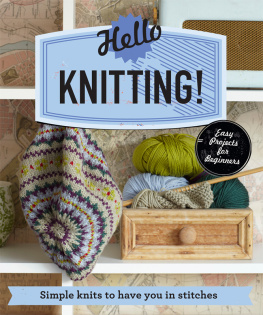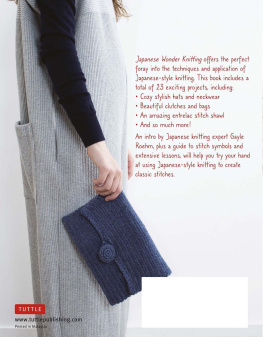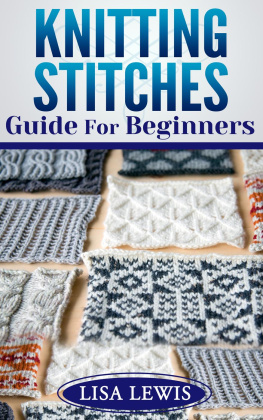 Seamless (or Nearly Seamless) Knits
Seamless (or Nearly Seamless) Knits
2011 by Andra Knight-Bowman  Martingale
Martingale
19021 120th Ave. NE, Suite 102
Bothell, WA 98011-9511 USA
ShopMartingale.com eBook Edition: 2013 No part of this product may be reproduced in any form, unless otherwise stated, in which case reproduction is limited to the use of the purchaser. The written instructions, photographs, designs, projects, and patterns are intended for the personal, noncommercial use of the retail purchaser and are under federal copyright laws; they are not to be reproduced by any electronic, mechanical, or other means, including informational storage or retrieval systems, for commercial use. Permission is granted to photocopy patterns for the personal use of the retail purchaser. Attention teachers: Martingale encourages you to use this book for teaching, subject to the restrictions stated above. The information in this book is presented in good faith, but no warranty is given nor results guaranteed.
Since Martingale has no control over choice of materials or procedures, the company assumes no responsibility for the use of this information. Library of Congress Cataloging-in-Publication Data
is available upon request. eISBN: 978-1-60468-241-0 Original Source ISBN: 978-1-60468-028-7 DEDICATION To Terry M. Bowman, my husband, my friend, and my hero. Without your love and support, I would be nowhere. I love you! ACKNOWLEDGMENTS All of the patterns were named after people who have had a significant influence in my life.
Thank you all! Also, a special thank-you to all of the yarn companies that supplied yarn for the garments in this book: Berroco, Cascade Yarns, Crystal Palace Yarns, Frog Tree Yarns, Knitting Fever, Kollage Yarns, Plymouth Yarn Company, Universal Yarn, and Westminster Fibers. 
 Contents
Contents  Welcome to Seamless (or Nearly Seamless) Knits! When I owned a yarn shop, the number-one complaint I heard from my sweater knitters was not wanting to sew the pieces together after they were completed. I agree; its not my favorite task to do either. Over the past few years, I decided to put together some seamless designs and soon realized that there are many different ways to make sweaters seamless and still make them in a range of sizes to fit all figures. Ive arranged this book in categories by how the sweater is made: First, the basic method starting from the bottom of a sweater and working your way up to the shoulders. Second, starting from the shoulders and working your way down to the waist.
Welcome to Seamless (or Nearly Seamless) Knits! When I owned a yarn shop, the number-one complaint I heard from my sweater knitters was not wanting to sew the pieces together after they were completed. I agree; its not my favorite task to do either. Over the past few years, I decided to put together some seamless designs and soon realized that there are many different ways to make sweaters seamless and still make them in a range of sizes to fit all figures. Ive arranged this book in categories by how the sweater is made: First, the basic method starting from the bottom of a sweater and working your way up to the shoulders. Second, starting from the shoulders and working your way down to the waist.
And, third (and one of my favorites), working in all different directions, usually side to side but combining the other directions along with it. I hope that you will enjoy this book as much as I enjoyed creating it and, when you sit down to knit, that you get the fulfillment that I have enjoyed for the past 37 years. Leave the stress of sewing seams aside. After all, knitting is our therapy. Isnt knitting
supposed to be relaxing? Andra Special Techniques and Tips Here youll find information on some of the techniques used in this book. Refer to Abbreviations on to familiarize yourself with new terms or to double-check abbreviations.
GAUGE Checking your gauge before you begin a project is essential, not only to make sure that the finished garment will fit correctly, but also to make sure you like the way the yarn is knitting up on the size needles youre using. To make a gauge swatch, use the stitch pattern and recommended needles. Cast on 20 to 24 stitches and work until your swatch measures 5". Bind off loosely. To measure the stitch gauge, place a ruler horizontally on the swatch. Mark the beginning and end of 4" with pins and count the stitches between the pins.
To measure the row gauge, place a ruler vertically on the swatch. Mark the beginning and end of 4" with pins and count the rows between the pins. If you have more stitches than recommended, knit another swatch using a larger needle. If you have fewer stitches than recommended, knit another swatch using a smaller needle. CAST ONS I read many years ago that there were almost 60 different ways to cast on for knitting. Let me share with you my favorite ways.
Long-Tail Cast On Normally I use the long-tail cast on, mainly because its the way I learned first. Not only does the long-tail cast on have great elasticity for sweater bands, but it also has a nice finished look. To make sure your tail is long enough, start with the tail end, wrap around the needle for the desired number of sts, and then make a slipknot. 1. Make a slipknot on one needle. Wrap the tail around your left thumb and the yarn thats connected to the ball around your index finger.
Hold both yarn ends in the palm of your hand with your remaining fingers.  2. With your right-hand needle, go under the loop on your thumb.
2. With your right-hand needle, go under the loop on your thumb.  3. Go over the top of the loop on your index finger and bring the yarn through the loop on your thumb. Slip your thumb out of the loop and use it to adjust the tension.
3. Go over the top of the loop on your index finger and bring the yarn through the loop on your thumb. Slip your thumb out of the loop and use it to adjust the tension.
You have cast on one stitch.  4. Repeat steps 2 and 3 until you have cast on the desired number of stitches. Cable Cast On This method is great when making buttonholes and also when casting on at the beginning or end of rows. 1. Make a slipknot and place it on the left-hand needle.
4. Repeat steps 2 and 3 until you have cast on the desired number of stitches. Cable Cast On This method is great when making buttonholes and also when casting on at the beginning or end of rows. 1. Make a slipknot and place it on the left-hand needle.
Insert the right-hand needle into the stitch, knit it but do not take it off of the left-hand needle. Place the new stitch on the left-hand needle.  2. Insert the right-hand needle between the two stitches on the left-hand needle; knit it as before and place it on the left-hand needle. Continue until you have the desired number of stitches.
2. Insert the right-hand needle between the two stitches on the left-hand needle; knit it as before and place it on the left-hand needle. Continue until you have the desired number of stitches.  Provisional Cast On There are different ways to create a provisional cast on.
Provisional Cast On There are different ways to create a provisional cast on.
This cast on is normally used when you need to remove the original cast-on edge so that you can add on knitting in the opposite direction. For example, when youre knitting a sweater from the top down, by removing the cast on from the shoulders, you wont have any seam at the shoulders. A provisional cast on also looks like the bind-off stitch, so its good to use when making a sweater from side to side. Use the same yarn as for the body of your garment but dont remove the cast on. 1. Using a crochet hook approximately the same size as your knitting needle and some waste yarn, crochet a loose chain for the desired amount of stitches, adding a few extra chain stitches to be safe.
Next page








 Seamless (or Nearly Seamless) Knits
Seamless (or Nearly Seamless) Knits Martingale
Martingale
 Contents
Contents  Welcome to Seamless (or Nearly Seamless) Knits! When I owned a yarn shop, the number-one complaint I heard from my sweater knitters was not wanting to sew the pieces together after they were completed. I agree; its not my favorite task to do either. Over the past few years, I decided to put together some seamless designs and soon realized that there are many different ways to make sweaters seamless and still make them in a range of sizes to fit all figures. Ive arranged this book in categories by how the sweater is made: First, the basic method starting from the bottom of a sweater and working your way up to the shoulders. Second, starting from the shoulders and working your way down to the waist.
Welcome to Seamless (or Nearly Seamless) Knits! When I owned a yarn shop, the number-one complaint I heard from my sweater knitters was not wanting to sew the pieces together after they were completed. I agree; its not my favorite task to do either. Over the past few years, I decided to put together some seamless designs and soon realized that there are many different ways to make sweaters seamless and still make them in a range of sizes to fit all figures. Ive arranged this book in categories by how the sweater is made: First, the basic method starting from the bottom of a sweater and working your way up to the shoulders. Second, starting from the shoulders and working your way down to the waist. 2. With your right-hand needle, go under the loop on your thumb.
2. With your right-hand needle, go under the loop on your thumb.  3. Go over the top of the loop on your index finger and bring the yarn through the loop on your thumb. Slip your thumb out of the loop and use it to adjust the tension.
3. Go over the top of the loop on your index finger and bring the yarn through the loop on your thumb. Slip your thumb out of the loop and use it to adjust the tension. 4. Repeat steps 2 and 3 until you have cast on the desired number of stitches. Cable Cast On This method is great when making buttonholes and also when casting on at the beginning or end of rows. 1. Make a slipknot and place it on the left-hand needle.
4. Repeat steps 2 and 3 until you have cast on the desired number of stitches. Cable Cast On This method is great when making buttonholes and also when casting on at the beginning or end of rows. 1. Make a slipknot and place it on the left-hand needle. 2. Insert the right-hand needle between the two stitches on the left-hand needle; knit it as before and place it on the left-hand needle. Continue until you have the desired number of stitches.
2. Insert the right-hand needle between the two stitches on the left-hand needle; knit it as before and place it on the left-hand needle. Continue until you have the desired number of stitches.  Provisional Cast On There are different ways to create a provisional cast on.
Provisional Cast On There are different ways to create a provisional cast on.